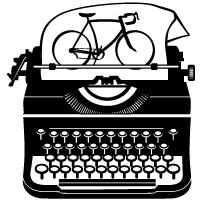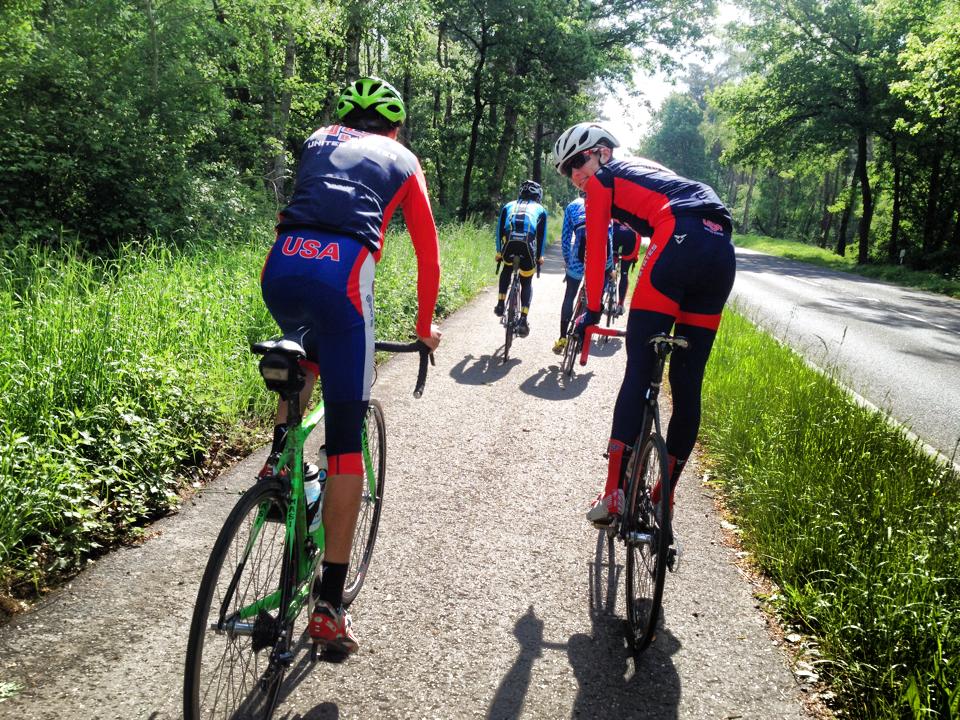Soigneurs may very well have the most thankless job in professional cycling. They take care of the grunt-work details necessary to keep a pro team running smoothly while remaining mostly anonymous. Sara Clawson is a sports massage therapist in Greensboro, North Carolina who’s making inroads to a soigneur career. This spring, she spent two months working as a soigneur with the US elite junior team at USA Cycling’s training center in Sittard, Netherlands. Over the next month, Sara’s writing (originally posted on her blog) will shed some light on the “swanny life†as she recounts her experience traveling around Europe working with the next generation of American professional road cyclists. In part two, Sara delves into her day to day as she preps for a race in France.
We’re in the car on a long drive to Bretagne, so I have a little bit of down time to write an entry — the first down time in a while!
I’m into my second week as a soigneur and learning fast — mostly from watching and doing, but a lot from making mistakes too. It’s a job with long expanses of furious intensity punctuated by periods of absolutely nothing to do, and at first it’s actually difficult to recognize when it’s appropriate to take a break. But I’m learning the general routine of everyday functions at the USA house, preparations for a race, and the things that need to happen once riders return from racing.
No two daily schedules are the same, but we generally start early with breakfast and a trip over to the Service Course, a separate location where all of the maintenance operations take place. If vehicles have just returned from racing, they need to be unloaded, thoroughly cleaned inside and out, and items inventoried. If the vehicle needs to make an immediate turnaround for another race, many of the items are re-stocked as needed and loaded straight back into the truck. If they won’t be used for a few days, everything is put back into stock, including things like sports nutrition products and race food, medical kits, chairs, laundry, and coolers. A running shopping list is kept of everything that needs to be kept on hand in supply and soigneurs shop nearly every day.
We head back to the USA house for lunch and typically start massages early afternoon, after the riders who aren’t away racing have finished their training rides and gotten a chance to shower and eat. I’ve been doing anywhere from 3 to 7 massages every day, around 30-45 minutes for each. Riders who have just returned from races, are heading off to races, or experiencing particular issues are the priority.
If we are preparing to leave for a race, at least one soigneur will make a shopping trip for race food and supplies. We have to prepare food for 5-7 riders each day of a race, which includes pre-race food, musettes during the race, and a post-race recovery meal to tide the riders over until meal time. The soigneurs are also responsible for preparing food for the mechanics and team directors during races. Water can be tricky, especially at races in rural areas, so we have to fill bottles at the USA house and purchase bottled water for the trip. The quantity of food we have to procure is truly incredible; it’s like feeding a small army that eats mainly carbs and sugar!
Bottles are washed and prepared the night before a race with plain tap water and hydration mix. The team is currently sponsored by OSMO nutrition, and they supply a variety of products. It isn’t safe to prepare bottles with mix more than a day ahead of time, though, in case the sports drink grows bacteria. A big stage race may require 500 bottles or more.
On the road and especially at longer tours, the soigneurs’ work increases exponentially. The riders’ every need must be addressed, from minor details like getting the wifi passwords for race hotel venues to treating major injuries. Generally, the team director drives the team car, the mechanic drives a box truck with bikes, laundry, and a full kitchen inside, and the soigneur drives the riders in the team van. There are two soigneurs going to Bretagne today, me and Robert, so we are sharing the driving.
Today is Wednesday and the race doesn’t begin until Friday, so we will have to do some more shopping once we arrive tomorrow. Having two soigneurs will make things much easier once the race stages start ending in different cities, which happens on Stage 3. Instead of one person having to do all of the race operations and hotel transfer, I will take care of the race while Robert drives to the next hotel and gets everything set up. I will have to get the riders to the stage and all set to go, then drive to the feed zone once they depart and get ready for all the food and bottle handoffs. In long stages, riders need to take in more food and water than they can carry in the race, so a feed zone is designated on the course for soigneurs to give the riders a bag, called a musette, containing bottles, bars, gels, a small can of soda, and a bit of high-energy food like cake or candy. These bags must be given to riders on the fly, sometimes in excess of 50 kph. I’ve gotten some practice, but I’m still a little nervous about being fast and accurate enough to feed all 6 riders. The worst thing a soigneur can do is a poor presentation of the musettes bag and letting go too late, which can cause the musettes to tangle in the bike or whip around and crash the rider. I’ll probably get the guys to help me out with another practice run tomorrow so I get really comfortable with all of them.
After the race, the riders need a quick high-carb meal to restore depleted muscle glycogen and help them recover for the next stage. This usually involves cooking white rice in the rice cooker and mixing with fatty sweets, like honey, peanut butter, and Nutella. They also need a high-protein recovery drink with some sugar in it (chocolate milk and almond milk mixed with spiced honey flavored whey are big favorites). Once nice thing about race food in Europe is that much less of it needs to be refrigerated — dairy and eggs are fine at room temperature. The soigneur wipes off legs, arms, and faces with sports wash and does quick first aid on anything that needs attention, and if all goes well helps riders get cleaned up for the podium if they have a top-3 finish! Then it’s back to the hotel for massages, bottle cleaning, food prep, and to bed to get up and do it all again the next day.
Make no mistake — this is a really difficult lifestyle and even the soigneurs working for pro teams make somewhat meager salaries for the amount of work the job entails. Days off are rare during prime racing season and the work isn’t easy to come by. So far I am really enjoying it; we’ll see if I’m singing the same tune in a month! The main thing is that the riders and other staff are all friendly and create a very energetic, positive atmosphere that emphasizes efficiency without frantic urgency. Bike racers have always been some of my favorite folks to be around. For now, a good night’s sleep is in order to prepare for what is sure to be a long week!

